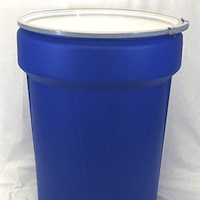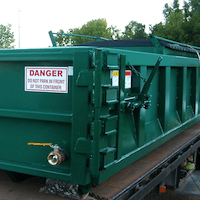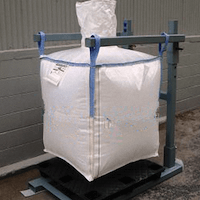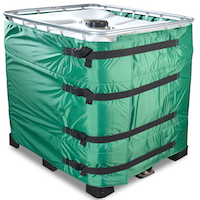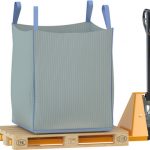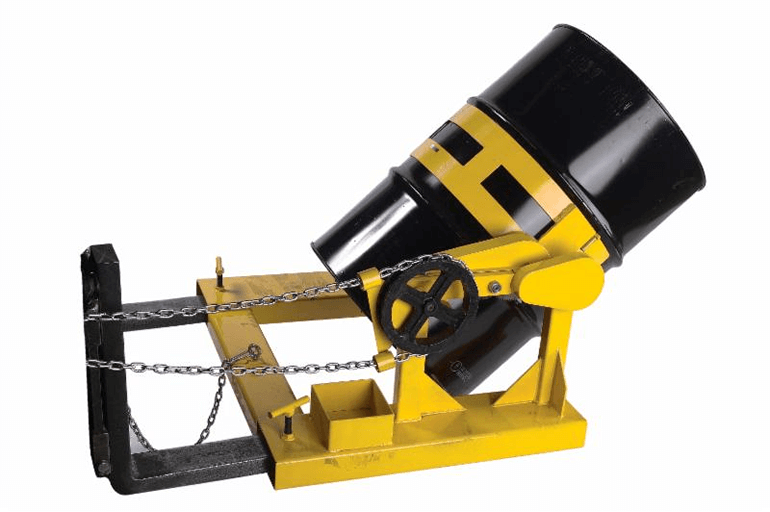
How To Safely Handle Drums
 Risks of handling a heavy 55-gallon (210 liter) drum – an example
Risks of handling a heavy 55-gallon (210 liter) drum – an example
- It can be hazardous to move a drum with your forklift
- Have you seen people manually roll a drum on the bottom rim?
- Ever see someone roll a drum down a makeshift ramp?
- There’s a better way to mix the contents of a drum than rolling it on the floor!
Identify the Hazards:
- Drums too heavy for people to handle safely.
- Flexible plastic drums that are difficult to grip.
- Drums stored in tight spaces.
- Slippery, cluttered or uneven floors.
- Contents shifting in a partially full drum can make it difficult to control or even dangerous.
- Dangerous drum contents
Address the Issues by educating employees:
- Acknowledge hazardous circumstances and procedures
- Check MSDS of drum contents
- Wear appropriate protective clothing, such as steel toe boots, gloves, safety glasses, etc.
- Ensure proper lighting and adequate space in work areas
- Provide the correct ergonomic equipment for safe handling of specific drums
- Label forklifts as required by OSHA if drum handling attachments are used
- Train employees on correct use of all drum handling equipment
Recommendations for drum handling safety. . .
Heavy drums should always be moved with proper drum handling equipment. Use a drum truck, forklift attachment, below-hook drum lifter or other equipment specifically designed for drum handling.
A full 55-gallon (210 liter) steel drum can weigh over 2,000 pounds (907kg), with typical weights of 400 to 800 Lb. (180 to 363 kg). When being moved, the contents of your drum may shift inside, making the drum difficult to control or even dangerous. There are also special considerations when handling a plastic drum or a fiber drum. Conditions such as restricted spaces and slippery or uneven floors can entail greater risks.
Mishandling a heavy drum can cause serious injury, damage the drum, waste valuable contents or contaminate the environment. Common injuries include a strained back, crushed fingers or hands, and foot trauma. Incidents of dropped drums, or drums rolling out of control, can also cause spills and damage.
Never Overload Your Drum Handler
Our drum handlers are designed to specific standards with engineered safety factors. . . but if someone exceeds the rated capacity, all bets are off! Under no circumstances should any modifications be made to to our machinery without factory authorization. Each model is designed to perform a specific job, and alterations may result in injury to operator or machine. Also, any modifications would void the warranty.
Engineered drum handling equipment is designed to handle specific types and sizes of drums, as listed in the Operator’s Manual for each model. DO NOT attempt to handle any other type of drum or object.
DO NOT attempt to operate a damaged or malfunctioning drum handler, or one with missing parts.
Safety conscious procedures for Drum Handling
Always use protective clothing
Eliminate risk factors
Drum handling safety requires a systematic approach to eliminate all possible causes of injury. Take proper precautions if the drum contents are hazardous or flammable. Refer to your MSDS for correct handling procedures. Always use appropriate protective clothing such as gloves, steel-toed shoes and eye protection. Environmental factors should be considered, such as adequate lighting and sufficient space to safely handle drums. Of course, cluttered, sloped or slippery floor surfaces increase the risks. Eliminate these conditions as much as possible, and clean up any spills. Replace any missing bungs or lids.
Always use proper equipment designed for the task when handling heavy drums. Train all employees in proper drum handling safety procedures and use of drum handling equipment.
Additional Resources
OSHA: Handling Drums And Other Containers

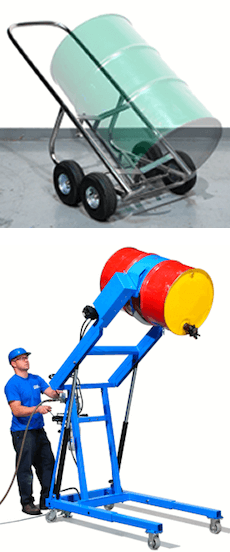 Risks of handling a heavy 55-gallon (210 liter) drum –
Risks of handling a heavy 55-gallon (210 liter) drum – 
 P.O. Box 8149
P.O. Box 8149